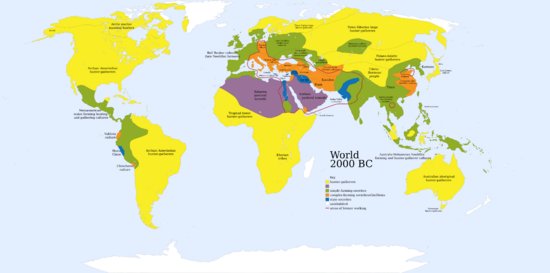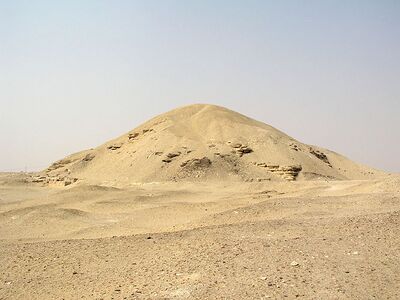History:20th century BC
From HandWiki
Short description: Century which lasted from the year 2000 BC to 1901 BC
The 20th century BC was a century that lasted from the year 2000 BC to 1901 BC.
The period of the 2nd Millennium BC
Events
- c. 2000 BC:
- Farmers and herders traveled south from Ethiopia and settled in Kenya.
- Dawn of the Capacha Culture in modern-day Colima, Mexico.
- Humans settle in Matanchén, modern day Nayarit, Mexico
- Arrival of the ancestors of the Latins in Italy.
- Town of Mantua was founded.
- First of the Minoan palaces on Crete. Site of palace complex Knossos started to become occupied.
- Bronze Age began in north Ancient China.
- Middle Jōmon period ended in Japan .
- Decline of Harappan civilization began.
- The Harappa Torso was sculpted by a member of the Indus Valley culture.[1]
- Vessel, from Asahi Mound, Toyama Prefecture, was made. Jōmon period. It is now kept at Collection of Tokyo University.
- Dogū, from Kurokoma, Yamanashi Prefecture, was made. Jōmon period. It is now kept at Tokyo National Museum.
- Stonehenge construction largely completed.
- Dawn of the Lal-lo and Gattaran Shell Middens pilings in the Philippines .
- Horses were tamed and used for transport.
- The last woolly mammoth goes extinct on Wrangel island.
- c. 2000 BC – 1900 BC: the "Priest-king torso" was sculpted at Mohenjo-Daro, part of the Indus Valley civilization.[2]
- c. 1995 BC: Pharaoh Mentuhotep II, Eleventh dynasty of Egypt dies.
- c. 1995 BC: Egypt: Pharaoh Mentuhotep IV died. End of Eleventh Dynasty. Pharaoh Amenemhat I started to rule. Start of Twelfth Dynasty.
- c. 1985 BC: Political authority became less centralized in Ancient Egypt.
- c. 1985 BC – 1795 BC:
- Rock-cut tombs at Beni Hasan were made. Twelfth Dynasty.
- "Hippopotamus", from the tomb of Senbi (governor) (Tomb B.3) at Meir was made. Twelfth Dynasty. It is now in the Metropolitan Museum of Art, New York City .
- 1974 BC: Erishum I became the thirty-third ruler of Assyria.
- February 27, 1953 BC: A very close alignment of the naked-eye planets took place in which these planets are together in a span of 4.3 degrees.
- March 5, 1953 BC: A computer calculated alignment of the naked-eye planets took place in a new moon, and in spring season, and is believed by researchers from NASA, to be the starting event for the Chinese calendar, as they followed descriptions from a 1st Century B.C. Chinese passage "Hong Fan Zhuan" by 'Liu Xiang', to search for this astronomical event being described to have happened about 2000 BC at Pegasus constellation (Yingshi).
- c. 1942 BC: The so-called king of Leubingen (today part of Sömmerda) was buried in a large barrow within a 66-foot-wide (20 m) stone cairn inside a ring ditch.
- 1932 BC: Amorite conquest of Ur.
- c. 1928 BC – 1895 BC: "Harvest scene", tempera facsimile by Nina de Garis Davies of wall painting in the tomb of Khnumhotep II, Beni Hasan. Twelfth Dynasty.
- c. 1920 BC: Jishi Gorge flood. It may have sparked the beginning of the first Chinese dynasty (Xia, Erlitou culture) [3]
- 1913 BC – 1903 BC: Egyptian-Nubian war.
- c. 1900 BC: Shalim-ahum and his son Ilu-shuma began to rule the city of Assur at around this time.
Inventions, discoveries, introductions
- c. 2000 BC: Glass appears.
- 2000 BC: In the Old Assyrian Empire, the Sumerian cuneiform had evolved into Old Assyrian cuneiform, with many modifications to Sumerian orthography.
- c. 1900 BC: Cacao is domesticated by the Mokaya in Guatemala.[4]
Sovereign states
References
- ↑ The Harappa Torso is now kept at the National Museum in New Delhi, India.
- ↑ The "Priest-king torso" is now kept at the National Museum of Pakistan, in Karachi.
- ↑ "Massive flood may have led to China's earliest empire". 2016-08-04. https://www.science.org/content/article/massive-flood-may-have-led-chinas-earliest-empire.
- ↑ Watson, Traci (22 January 2013). "Earliest Evidence of Chocolate in North America". Science. https://www.science.org/content/article/earliest-evidence-chocolate-north-america.
 |



